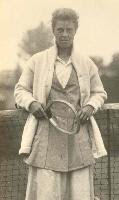Never write if you can speak; never speak if you can nod; never nod if you can wink.
--Martin Lomasney
In her book The Fitzgeralds and the Kennedys, Doris Kearns Goodwin describes him through the eyes of John Francis "Honey Fitz" Fitzgerald, John F. Kennedy's grandfather:
Fitzgerald described this first meeting in vivid detail, recalling the powerful presence Lomasney projected as he sat in his chair surrounded by a half-dozen loyal aides. A thickset, well-muscled man whose most outstanding feature was a hard rocklike jaw that made him a cartoonist's friend, Lomasney was a bachelor whose entire life was given to the building of his political machine, the Hendricks Club. He lived a simple, low-key life, renting a small apartment and wearing the same old battered straw hat year round, but to the people of the West End he was a god. Arriving early each morning at his headquarters, Lomasney worked 365 days a year, caring for "his" people in all phases of their lives.
Lomasney had supported Fitzgerald in his successful campaigns for Massachusetts state senate in 1892 and Congress in 1894. But when Fitzgerald sought the position of Mayor of Boston in 1905, Lomasney supported another Democrat, Ned Donovan, in the primary. Fitzgerald beat Donovan for the Democratic nomination, and all the ward bosses, except Lomasney, threw their support behind him in the election. Lomasney announced that he wouldn't support Fitzgerald, and "his" people voted for Frothingham, the Republican candidate. (It was the first time in years that Ward 8 had voted for a Republican candidate.)
In spite of the loss of Lomasney's support, Fitzgerald was indeed elected Mayor, a position he would assume on January 1, 1906.
But the story I most love about Lomasney, and the rollicking world of Boston Irish Democratic politics, happened a few years earlier, in 1898.
As told by James J. Connolly in The Triumph of Ethnic Progressivism: Urban Political Culture in Boston, 1900-1925, Lomasney was battling with the Board of Strategy over a seat in the State Senate that represented the West End, along with the North End and part of East Boston. Lomasney backed Daniel Rourke, one of his Ward 8 supporters, for the seat, while his opponents promoted the candidacy of William J. Donovan of East Boston. Donovan had received more votes in the caucuses, but Lomasney controlled the nominating convention (which made the formal choice), and hatched a scheme to try and deliver the nomination for his candidate.
With nominations due at the Massachusetts State House in downtown Boston at 5 P.M. on October 20, Lomasney scheduled the convention for 4:30 of the same afternoon and announced that it would be held across Boston Harbor, in an East Boston hotel. SInce ordinary means of transportation from East Boston to downtown required forty minutes, it was widely suspected that Lomasney planned to use a ferry or another boat to deliver the nomination papers to the State House before the deadline. Donovan's supporters . . . secretly booked all the available rooms in the hotel and arranged to have men loyal to the Quincy administration manning the ferries running to downtown so they could prevent a Lomasney messenger from reaching the State House.
The result was a competition between the two factions to claim the nomination that involved parliamentary maneuvering as well as races on foot, bicycle, and boat. Rourke's delegates, led by Lomasney, arrived at the hotel late on the afternoon of October 20, where they assembled in a room Lomasney had surreptitiously booked several weeks earlier. After tricking Donovan backers into leaving the room, they quickly called the convention to order and nominated Rourke. Not to be outdone, Donovan's delegates held a separate convention across the hall and selected their own man. A race to deliver the nominations ensued. Lomasney dispatched a decoy messenger on a city-run ferry, which was soon stranded in the middle of Boston Harbor, purportedly with engine trouble. He then sent a sprinter--a Boston College football star--to a private boat that sped across the harbor. From there, a well-known local bicycle racer pedaled the nomination to the State House, arriving at 4:49 P.M. In the meantime, Donovan's papers were rushed downtown on a second ferry and handed off to another bicyclist. But his bicycle chain broke, and he arrived three minutes after Lomasney's messenger. . . . Lomasney's forces claimed victory.
Unfortunately for Lomasney and Rourke, the Ballot Law Commission eventually ruled Donovan the nominee.
Lomasney would go on to be a powerful force in Boston politics until his death in 1933. And if you come down Causeway Street (where Lomasney's headquarters were), pass North Station, and bear right, you'll find yourself on Lomasney Way for a block or so. Tip your hat to Martin as you go by--they don't make 'em like that any more!
Illustration Credits and References
The photo at the top of this post is of North Station on Causeway Street in Boston, taken in the 1890s. It is from the Library of Congress collection.
Illustration Credits and References
The photo at the top of this post is of North Station on Causeway Street in Boston, taken in the 1890s. It is from the Library of Congress collection.




